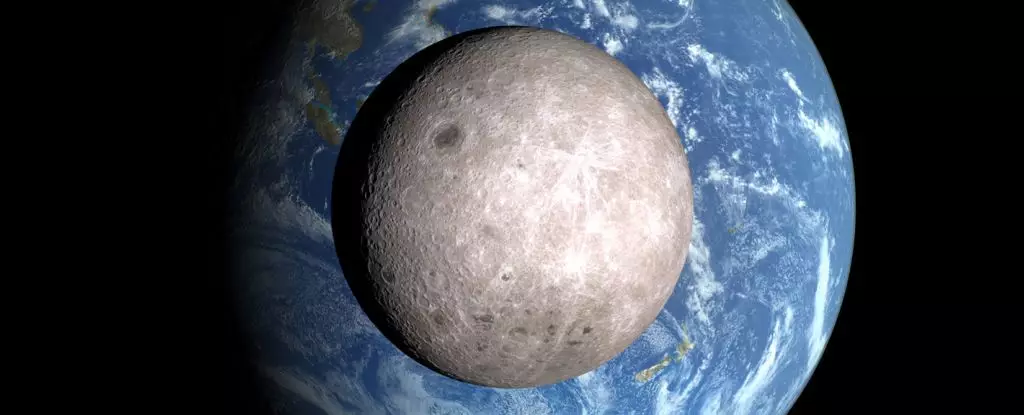The lunar landscape, our nearest cosmic neighbor, harbors secrets that challenge our understanding of planetary formation. New scientific studies, particularly recent analyses derived from lunar samples brought back by China’s Chang’e-6 mission, reveal a startling asymmetry: the far side of the Moon displays a markedly lower water content than the hemisphere that faces Earth. This imbalance not only sparks intrigue but also serves as a focal point for questions regarding the processes that shaped our Moon in the wake of a colossal impact that occurred approximately 4.5 billion years ago. The implications of these findings stretch beyond mere curiosity; they might refine our understanding of Earth’s own geological history.
Cratered Differences and Geological Disparities
Upon closer inspection, the Moon’s surface narrates a tale of two worlds. The far side, rugged with craters from relentless cosmic collisions, starkly contrasts the near side’s relatively smoother basalt plains, known as maria. This dichotomy raises questions on how two halves of the same celestial body can exhibit such disparate characteristics. The core of this enigma lies in their respective geological compositions. Scientists from the Chinese Academy of Sciences posit that the disparity in water abundance reveals critical insights into the Moon’s formation process, which remains an essential cornerstone of planetary science.
The ‘giant impact hypothesis’ offers a framework to understand these differences, positing that the Moon was born from debris resulting from a cataclysmic collision with a Mars-sized body, commonly referred to as Theia. The collision purportedly led to a magma ocean that cooled unevenly, with heat from Earth preserving warmth on the side facing our planet. This variable cooling potentially explains why the far side, which remains shrouded in mystery until recently, is both geologically older and less rich in volcanic plains.
A Revelatory Study
The Chang’e-6 mission marked a pivotal moment in lunar studies, yielding samples from the elusive far side that scientists have long sought after. The examination of these rocks revealed a strikingly low water content—approximately 1 to 1.5 micrograms of water per gram of basalt. This scarcity not only validates suspicions held by the scientific community but also enriches the narrative of a Moon long thought to be a simplistic and uniform body in orbit around Earth.
The chemical analysis dazzles with implications: it suggests that the far side, potentially subjected to cataclysmic impacts, might have shed much of its volatile materials, creating a dry mantle. While it would be easy to dismiss this as a mere statistical anomaly, the reality is far more captivating. The consistency of these findings with existing models of lunar formation hints at a grander scheme of interstellar phenomena, where even the simplest interpretations of celestial bodies can lead to profound realizations.
Science’s Perpetual Chase
Despite the revelations, science remains engaged in a tantalizing chase. The analysis of the South Pole-Aitken Basin, the focal point of the Chang’e-6 mission, raises further questions about the Moon’s geological history. Since the basin spans a quarter of the lunar surface, it’s plausible that it may have once held secrets even more profound than our current understanding permits. Could there be wetter regions hidden within the lunar crust, coveting their mysteries until further examination occurs? The thirst for knowledge propels scientists to propose expeditions for additional samples, fueling the notion that even in our well-trodden pursuit of scientific truth, the Moon still has many cards to reveal.
A Call for Broader Exploration
The debate surrounding the Moon’s water distribution invokes broader considerations regarding our approach to planetary exploration. As space agencies around the world set their sights on lunar missions, it is imperative to prioritize interdisciplinary studies that connect geophysics, chemistry, and astrobiology. A well-rounded exploration strategy not only benefits lunar science but also lays the groundwork for future missions to more distant celestial bodies, instilling a greater understanding of not just our Moon, but the universe at large.
In an age where the call for scientific collaboration and transparency is stronger than ever, the revelations from the Moon should be a clarion call for ongoing research. The unexpected hydrological narrative posed by the Chang’e-6 mission urges scientists to reassess their paradigms about not just the Moon, but also the larger cosmic dance of planetary formation and evolution. No longer do we view the Moon through the simplistic lens of an inert satellite; instead, it transforms into a crucible of scientific inquiry rich with potential.

